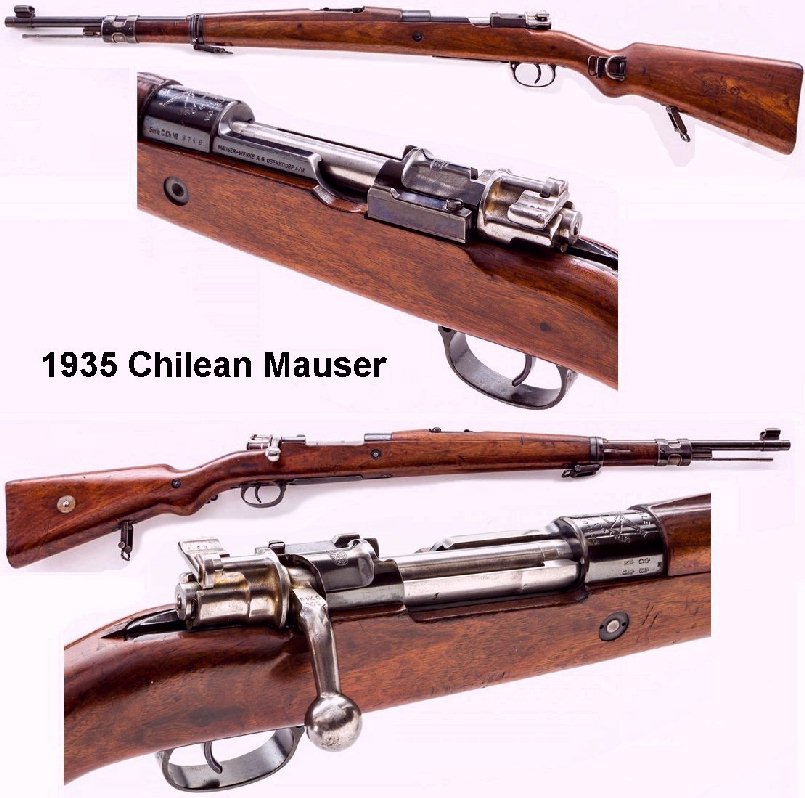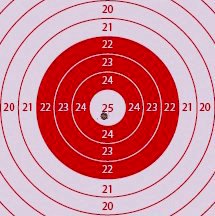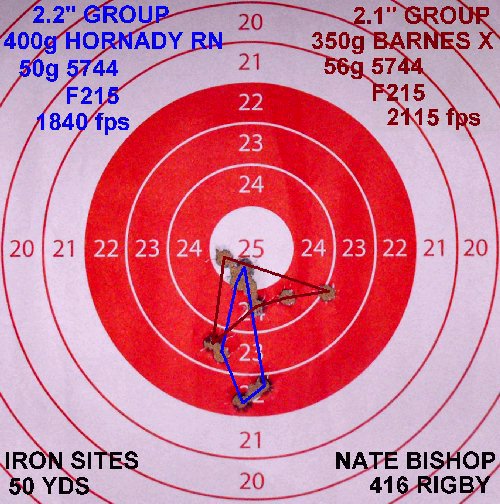

 The Accurate Reloading Forums
The Accurate Reloading Forums  THE ACCURATE RELOADING.COM FORUMS
THE ACCURATE RELOADING.COM FORUMS  Rifles
Rifles  Custom Built Rifles
Custom Built Rifles  A Custom built 416 Rigby Mauser by Nate Bishop
A Custom built 416 Rigby Mauser by Nate BishopGo  | New  | Find  | Notify  | Tools  | Reply  |  |
| One of Us |
Originally posted by buckstix: Hello All, Every so often an Amazing Custom Rifle comes along. This rifle was talked about on another forum about 3 or 4 years earlier. I had been following it for about that long, and finally in 2016 I convinced myself it to take up permanent residence here in Wisconsin. My mission with this posting is to share the details of this marvelous custom rifle and what I know of its builder, Nate Bishop. The unique serial number and proof mark stamping show that this rifle started its life as a Military 1935 Chilean Mauser Carbine. It was no different than any other of the thousands made for Military Service. Its exact History is unknown - just another Oberndorf Mauser that was a WWII bring-back. It originally looked like this: http://buckstix.com/buckpics/416forun4.jpg  In 1987, this common Military rifle, was transformed by Nate Bishop, a Master Gunmaker from Albuquerque, NM, into a Custom Safari Rifle in 416 Rigby Cal. Nate was a self taught Master. He told others he was inspired by the famed stock-maker, Leonard Mews. Nate Bishop built this rifle for the American Custom Gunmakers Guild Show held in March, 1987. Nate signed and marked this stock as such in he barrel channel. It is not known if he was a member of the Guild at that time, building this rifle to show his skill, or if he was attempting to be accepted into the Guild by, building this rifle to show his skill. It is amazing that this common Military Mauser Carbine, with its standard length action, could be so specially modified to take the "Super-Long" 416 Rigby cartridge. For the most part, all rifles in 416 Rigby caliber require "Magnum" length actions. This is not a "stretched and re-welded" action. Rather, this sleek beauty is Masterfully modified with custom bottom metal to encompass the cartridge. It tips the scales at a mere 8 pounds 12 ounces. Nate often commented that this rifle was the "Best Quality" Custom Rifle that he had ever built. Nate wrote articles on Custom Stock Making and Custom Gun Building in Guns Magazine from 1956 - 1962. He also wrote in Gun Digest in 1961 and 1969. He worked mostly with "Big Bore" Safari rifles and 416 Rigby was his favorite caliber. Elmer Keith had several Custom Big-Bore Rifles that were built for him, or stocked for him, by Nate Bishop. Keith's "Gun Notes" in Guns Magazine often commented as such giving Nate praise. The following photos show Nate's skill - with dozens of special nuances that he incorporated into this rifle. http://buckstix.com/buckpics/416forun1.jpg  http://buckstix.com/buckpics/416forun2.jpg  http://buckstix.com/buckpics/416forun3.jpg  Interestingly, a detailed examination of this rifle showed it to be totally "unfired" since its customization and conversion to 416 Rigby caliber back in 1987. Given that fact, and since I wanted to shoot the rifle, my biggest concern was the installation of the iron sites. It didn't look like they had ever been adjusted to "zero-in" the rifle. In fact, it appeared that both the front and rear sites were simply centered on the top of the barrel. They looked good, but would the work? Well, I had a chance to test fire the rifle. I used relatively light loads because the rifle is a bit on the light side at 8-3/4 pounds, and I didn't want to pound it, or me, nu-necessarily. I just wanted to have some fun shooting it. My concerns were for not. It seems that Nate knew what he was doing when he installed the sites as well. Here is the first shot from the rifle. http://buckstix.com/buckpics/firstshot.jpg  And here are the other 9 shots. I never touched the sites. I fired 2 loads, 350g and 400g. Combined they shot into 2-1/2" with each individual group measuring slightly over 2". That's about as good as my eyes will do these days. I think with heavier loads and the resulting increased recoil, there will be a slight rise of the group putting "all" the shots surrounding the bull. http://buckstix.com/buckpics/bishtarg1a.jpg  I have also obtained some information about Nate Bishop from one of the current members of the American Custom Gunmakers Guild. Nate's father was the founder of the well known Company of "E.C. Bishop & Son" in Warsaw Missouri. That makes Nate the "& Son" of that famous Company. The Company E.C. Bishop & Son originally made wooden railroad ties, and later moved into making gun stock blanks and complete stocks, of which they turned out hundreds of thousands for the U.S. Military during WWII. During WWII, Nate joined the U.S. Air Force and upon his returning 5 years later, he took over the Finishing Department at the Bishop Factory. Then in the early 1950's, his father sold the family Company, although the name stayed the same. It was at that time that Nate turned to Custom Stock making as a full time Business and later became a member of the Custom Gunmakers Guild. Nate once commented that it takes up to 150 hours to craft a Custom stock and that the Customer was not just buying a fancy piece of wood, rather, he was buying a piece of the Craftsman's Life. He went on to say that he could only craft one stock per month that would meet his personal specifications. The 2 rifles shown in this link below have the initials NB stamped in the stock's barrel channel. Perhaps they are also examples of Nate's talent. http://forums.accuratereloadin...1019521/m/2191052072 " .... you never pay too much for something, you only buy it too early .... " How to Hunt Wisconsin Whitetail Deer with a Cannon How to Hunt Feral Cats with a Mortar | ||
|
| One of Us |
Very nice!!! DRSS | |||
|
| one of us |
Interesting rifle. Not a big fan of that cheekpiece on any rifle much less a heavy rifle but was probably "artsy" for the time. Glad you like it and it shoots well. On the plains of hesitation lie the bleached bones of ten thousand, who on the dawn of victory lay down their weary heads resting, and there resting, died. If you can talk with crowds and keep your virtue, Or walk with Kings - nor lose the common touch... Yours is the Earth and everything that's in it, And - which is more - you'll be a Man, my son! - Rudyard Kipling Life grows grim without senseless indulgence. | |||
|
| One of Us |
I would be afraid of shooting any DG rifle without at least one crossbolt. A 416 should have 2. | |||
|
| One of Us |
Pretty rifle, nice wood. Somehow I think external crossbolts might detract from the picture. I wonder if Mr Bishop didn't just install internal crossbolts? | |||
|
| One of Us |
One must keep in mind that the idea of cross bolts is to have as much metal to wood contact as is possible to spread forces of recoil. Through (external) cross bolts just gives that much more area. | |||
|
| One of Us |
I just finished beefing up a Ruger RSM in 375 by removing the original cross bolt and doing a rear one. I used 5/16-18 threaded rod, drilled the holes and tapped the wood all the way through, counter-sunk the exterior about 1/8" and plugged them with 1'2" pieces of ebony turned from ebony scrap I had to alter the middle screw and plug existing inlet to gain more room for the crossbolts Jim Kobe 10841 Oxborough Ave So Bloomington MN 55437 952.884.6031 Former Professional member American Custom Gunmakers Guild | |||
|
| One of Us |
So was this a lengthening of the action or just judicious changing of where the bolt stop was and changing the size of the ejection port? I recall that Harry Selby’s .416 was a standard length K98k modified by Rigby… I tried to get Jim to do that for me… he said he wasn’t that crazy! | |||
|
| One of Us |
Hello crbutler, The bolt stop was modified to allow more rearward travel of the bolt, and the feed throat was modified to feed the longer cartridge, and the ejection port has a small circular cut to allow clearance for removing a loaded round. These modifications are similar to those done on Harry Selby's .416 Rigby K98. " .... you never pay too much for something, you only buy it too early .... " How to Hunt Wisconsin Whitetail Deer with a Cannon How to Hunt Feral Cats with a Mortar | |||
|
| Powered by Social Strata |
| Please Wait. Your request is being processed... |
|
 The Accurate Reloading Forums
The Accurate Reloading Forums  THE ACCURATE RELOADING.COM FORUMS
THE ACCURATE RELOADING.COM FORUMS  Rifles
Rifles  Custom Built Rifles
Custom Built Rifles  A Custom built 416 Rigby Mauser by Nate Bishop
A Custom built 416 Rigby Mauser by Nate Bishop

Visit our on-line store for AR Memorabilia

